Don't Be Afraid to Sample These 6 Indie Halloween Treats
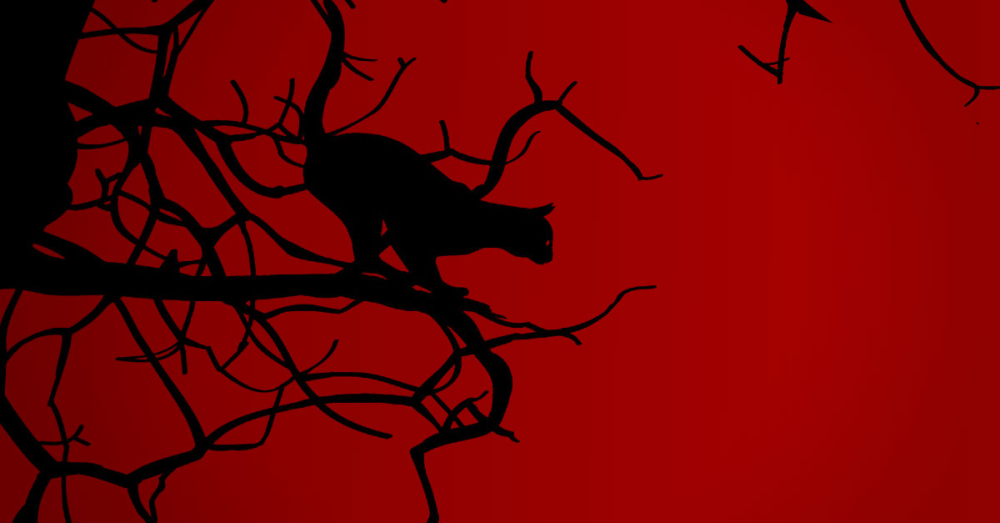
Do you already have fake cobwebs and rubber spiders decorating your house? Is your iPod playing This is Halloween on repeat? Do you have The Nightmare Before Christmas queued up on Netflix? You are definitely feeling the Halloween spirit. But one can never have too much creepy this time of the year, so prepare to get spooked by this fright-tastic selection of great indie Halloween books we’ve reviewed. We’ve got ghosts, ghouls, and hauntings of every kind. You might just want to buy yourself a bowl of candy and read all night long. Get your costume, your candy, and your book—things are about to get scary.
The Girl Who Ignored Ghosts
The Unbelievables Book 1
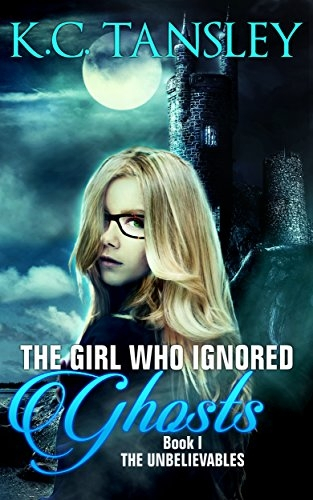
K. C. Tansley
Beckett Publishing Group
Softcover $12.99 (243pp)
978-1-943024-00-1
Buy: Local Bookstore (Bookshop), Amazon
Those who enjoy suspense, ghost stories, and a little hint of romance are sure to devour Tansley’s novel and its eventual sequels.
Supernatural and romantic elements are woven together nicely in K. C. Tansley’s first book in the Unbelievables series, The Girl Who Ignored Ghosts. Though geared towards young adults, people decades older are sure to enjoy the palpable suspense woven throughout the novel.
Kat Preston is a teenage prep-school student who, for as long as she can remember, has had the ability to communicate with ghosts. Most of them just want the living to help them resolve conflicts they had when they were alive, but some want much more. After a short possession by one of these ghosts, Kat swears to do the thing that most drives them off: not believe in them. This succeeds just fine until she is called to help her professor with a huge research project on the Isle of Acacia, the site of a long-ago mystery still left unsolved. It’s up to Kat and her team to find out what really happened on Sebastian Radcliffe and Cassie Mallory’s wedding night in 1886, when the couple disappeared from their room, which was left covered in blood. A curse also began that night that will take the life of every succeeding Radcliffe heir, and it’s about to kill the latest one—unless Kat can find a way to stop it.
Tansley takes those who are willing to suspend their disbelief on a fairly enjoyable ride. Kat Preston is easy to care about and seems relatable—except for the whole seeing-ghosts thing. The central plot of The Girl Who Ignored Ghosts is time travel for Kat and Evan, a fellow team member. Aside from the fairly strange way Tansley makes that happen, reading about the two teens inhabiting the bodies of those central to the Sebastian/Cassie mystery is riveting. Some of the characters can be tricky to keep straight, but it’s interesting how the ones of modern day end up connected to those of old.
It’s obvious from the last pages that there will be many more adventures for Kat and her team.
KELLY THUNSTROM (August 27, 2015)
The Hanging Tree
A Novella
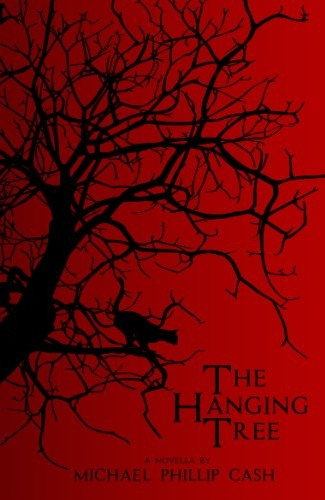
Michael Phillip Cash
CreateSpace
Softcover $6.99 (90pp)
978-1-4922-7451-3
Buy: Local Bookstore (Bookshop), Amazon
A short but mesmerizing tale, this spine-tingling test of the human spirit quite literally takes on the ghosts of our ancestors in an attempt to neutralize their mistakes.
Supernatural entities threaten to suppress free will in this fate-propelled plot. A twenty-first-century story embarks on a frightening jaunt into the 1600s and early 1900s, delving into the disturbed emotions of five historical characters who cannot be laid to rest.
Beneath the boughs of an old tree in contemporary Long Island, a teenage girl must face the consequences of a sour relationship with her father, while a boyfriend whom she trusted succumbs to lusty temptation—or perhaps forces beyond his control: “Chad felt different there. His muscles pulsed with an energy he didn’t understand, like he drank too many of those energy drinks. His blood felt thick, sluggish in his veins; he was aroused. He looked down at Arielle, his eyes narrowed, considering what he would do with her. His thoughts felt foreign, yet he didn’t try to stop thinking them.”
This haunting novella explores the consequences of actions taken centuries ago in Oyster Bay, examining the long-term, karmic aftereffects. Creepy, without a doubt, but decidedly staged for maximum impact, The Hanging Tree teeters on the brink of horror without fully crossing over the genre’s boundary. The underlying purpose seems to be one of vague revenge—lessons learned and prices paid. In short, a curse must be dissolved before peace can be attained. Witchcraft is the solution.
A short but mesmerizing tale, this spine-tingling test of the human spirit quite literally takes on the ghosts of our ancestors in an attempt to neutralize their mistakes. Though written with a commercial rather than a literary slant, a philosophical question adds an intellectual element to this Halloween-style entertainment. What is free will?
Arielle, an innocent young woman instilled with the best intentions, must go beyond the basics of knowing the difference between right and wrong as she deals with dead people who perceive the world in a different light. Only a common-sense approach will resolve her nightmare. The story jumps at a rapid rate from the viewpoint of one character to the next, creating fear from more than a single perspective.
A strong command of language and the ability to rivet attention both serve to captivate, but the combination thrusts this eerie escapade into overdrive, conveying too much in too short a format. Nothing is wrong with this novella, yet the intriguing situation, which features multiple characters, may have been more appropriate for a novel. Scenes tend to be implemented at an unnaturally accelerated pace. Slick packaging and a standout cover depicting a leafless black tree against a crimson background sets this work apart from mediocre competition in genre fiction.
A resident of Long Island and a novelist with a degree in English as well as an MBA, Michael Phillip Cash has loosely based his story on a real-life tragedy surrounding an oak tree where an accident occurred in the early twentieth century. His familiarity with the region infuses his work with life and authenticity.
JULIA ANN CHARPENTIER (December 20, 2013)
Twilight Tales
A Collection of Chilling Poems
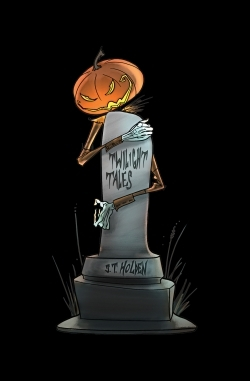
J. T. Holden
Kuro Books
Softcover $8.99 (114pp)
978-1-937696-00-9
Ranging from the ghostly to the gruesome, the poems in J.T. Holden’s chilling new collection, Twilight Tales, are filled with atmospheric rhymes and eerie images.
The twenty-two poems are roughly organized into four main sections, with a fifth section, “Two for the Road”, containing two additional poems. Holden draws material from classic horror elements, like mysterious murders, bloody corpses, the undead and vampires, and evil scarecrows, but some of the most interesting works are inspired by unique figures like La Llorana, of Mexican legends, and The Dullahan, a headless fairy from Irish myths. Subjects even extend to Shakespeare’s plays and a young Edgar Allan Poe, and a number of poems stem entirely from Holden’s imagination.
The mix of inspirations makes for a rather eclectic group of poems, with each one being entirely different from another. But whether depicting a bloody war from medieval times or the deadly Bloody Mary, Holden’s overall collection is wholly creepy rather than melancholy.
Holden’s previous work, Alice in Verse: The Lost Rhymes of Wonderland, was praised for its clever rhymes and fluidity, and the same can be said for this volume. His rhymes don’t typically feel forced, but rather easily blend into a seamless rhythm and flow. Descriptions of whispered “bewitching sighs” and coffins “soaked with steaming gore” conjure vivid images and palpable tension.
Though the easy cadence of the works can be appreciated by anyone, the appeal of this book is entirely dependent on a reader’s level of interest. Some poems contain such grisly elements that it is clearly not appropriate for younger people. Other pieces may not have the depth for adult readers or older teens, a detriment that could be outweighed by the unique subject matter and creativity.
Johnson’s illustrations appear at the beginning of each section, while all but one of Kelly’s are located in an additional section entitled “The Lost Illustrations of Twilight Tales,” as they were initially intended to accompany individual poems. Johnson’s work in particular seems slightly more sophisticated than the poems themselves. Unfortunately, much of the detail in the work is lost in an overly-blackened printing. The decision to not integrate Kelly’s illustrations into the text is appropriate given how different the two artists’ styles are.
Though not entirely cohesive or consistent, this book is a unique option for Halloween, particularly for those looking for physical chills.
ALICIA SONDHI (March 19, 2012)
No Reflection
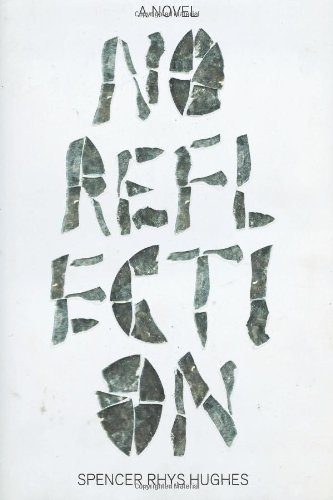
Spencer Rhys Hughes
Spencer Rhys Hughes
Softcover $13.79 (280pp)
978-0-615-81809-2
This high-stakes paranormal thriller grabs attention from the first page to the unexpected end.
Blood, gore, and mutilation in the repugnant underworld of New York put an anxious woman in the throes of a life-or-death investigation—a chase that may lead to her own demise in this terrifying urban fantasy. An action-packed, paranormal thriller teetering on the brink of madness, No Reflection pauses barely long enough to contemplate internal fears.
An actor as well as an author, Spencer Rhys Hughes draws from his familiarity with New York City to write No Reflection, his debut novel. An eccentric air and an imaginative slant on urban fiction shine through in this fascinating book. Written in a unique voice, Hughes blends private detective mystery with deadly horror and has a clearly developed, distinctive style.
The dangers here are real, not an irrational figment of one’s imagination due to stress. “The hand was cold, smooth and cold, and she knew whose it was because it could only have been the Man’s hand, his frigid grip, all ice and frost, feeling like it had never left since the attack, and it could only have been his voice, his breath, rank and warm, purring into her ear.”
As in many plots with high stakes, the tendency to barrel forward without considering less-significant details, such as proper formatting and meticulous line editing, is apparent in this otherwise-riveting novel. Spaces between paragraphs, minor typos, and odd use of capitalization for emphasis detract from a quality story.
If rewritten as a screenplay, this nightmare on espresso would be appropriate for the horror genre during a Halloween movie festival. At no point does the story lose the attention-grabbing impact needed to keep an audience captured until the unexpected end. Even a seasoned critic will not want to stop reading.
Here, a feeling of impending doom adds to the description of a grotesque, foreboding dream. “She turned and saw a creature, some foreign being, too beautiful to be human. Then it grew closer, emanating its own light, and became hideous. Its face was scarified and dense with excised tissue and misapplied make-up. … It held a paring knife in its right hand, and walked towards her with fluid strides, floating above the ground by an inch.”
Dirty subways, dank city dives, and dangerous neighborhoods create an ominous atmosphere with a perfect mixture of dark and depressing—exactly what the horror enthusiast seeks in entertainment. With more focus on manuscript preparation and an improved production process, Edgar Allan Poe would be proud to shudder at this chilling, unnatural tale.
JULIA ANN CHARPENTIER (November 26, 2013)
Peripheral
Tales of Horror at a Glance
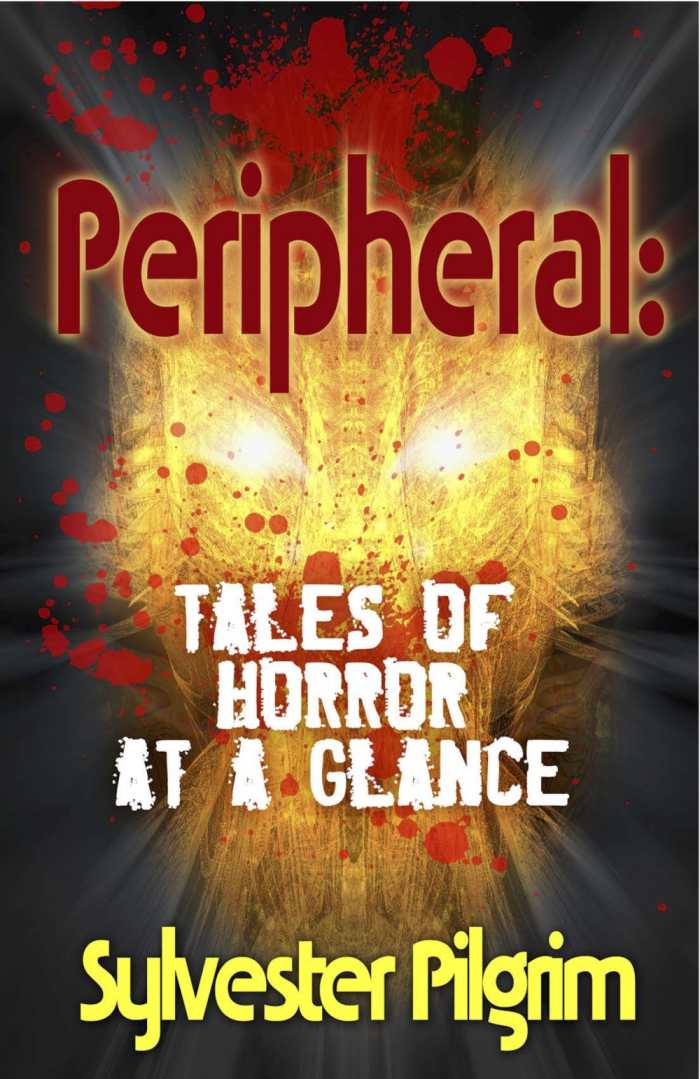
Sylvester Pilgrim
PRA Publishing
Softcover $15.00 (228pp)
978-1-941416-04-4
Buy: Amazon
Peripheral showcases an impressive range of human emotions and the unsparing dark imagination of its author.
A flash of something in the distance, real or imagined, catches the eyes of the characters in Sylvester Pilgrim’s short story collection, Peripheral: Tales of Horror at a Glance. Even his most ruthless protagonists experience fear of the unknown, rashness, wrong decisions, then consequences meted out in blood. Pilgrim takes his characters to the darkened brink of existence, to the shadowy periphery where nightmare and reality become indistinguishable. The book is a bloody good read.
With nineteen stories, Peripheral is difficult to characterize. Classic horror conventions are at work in several pieces, including the title story, which, strung out over four installments, revolves around a demon trying to break into the earthly realm. Other pieces, such as “’Til Death,” resemble pulpy crime thrillers, replete with hardened hit men and drug-addled femmes fatales. Pilgrim mixes horror and crime elements in “Self-Portrait” and “Reflections.” He also experiments with perspective and voice in the short, cleverly disturbing monologue “Inner Demon,” and in “Dinner Date,” which is relayed almost entirely in text messages.
On the whole, the author proves adept at characterization and pacing, carefully, often methodically, developing his characters and building suspense. When he doesn’t do this, it shows. Such is the case in “The Mechanic,” a generic tale about a grisly serial killer. Character and plot are thinly developed, and Pilgrim, a fan of twist endings, ties up the story in predictable fashion. Much the same could be said for “Dinner Date,” if not for its novel use of text messages. Both stories feel like uninspired filler.
But Pilgrim dazzles with “Nemesis” and “Last Call.” The former is perhaps the goriest story, but also the most imaginative, becoming a brilliant allegory on life and death. “Digging deep within, he searched,” Pilgrim writes of his embattled protagonist Hero. “He looked for what he needed to fight. The conviction he needed in order to continue, why he should stand and not run. He found the answer in the end. He would fight because he did not want to cause her pain.”
“Last Call” stands out as the collection’s best story and perhaps the closest thing to literary fiction. It contains little, if any, supernatural elements. It is a blunt, raw human story of two lonely people trying to find answers in a cruel world. “And I would say that sometimes we all do foolish things because of love,” a heartbroken man tells a complete stranger over the phone. In this piece, Pilgrim’s twist ending is devastating.
Rooted in genre conventions, Peripheral showcases an impressive range of human emotions and the unsparing dark imagination of its author. It is a brutal and bloody ride, but one worth taking for those unafraid to explore the dark boundaries of human, and nonhuman, experience.
SCOTT NEUFFER (August 19, 2015)
Sucker
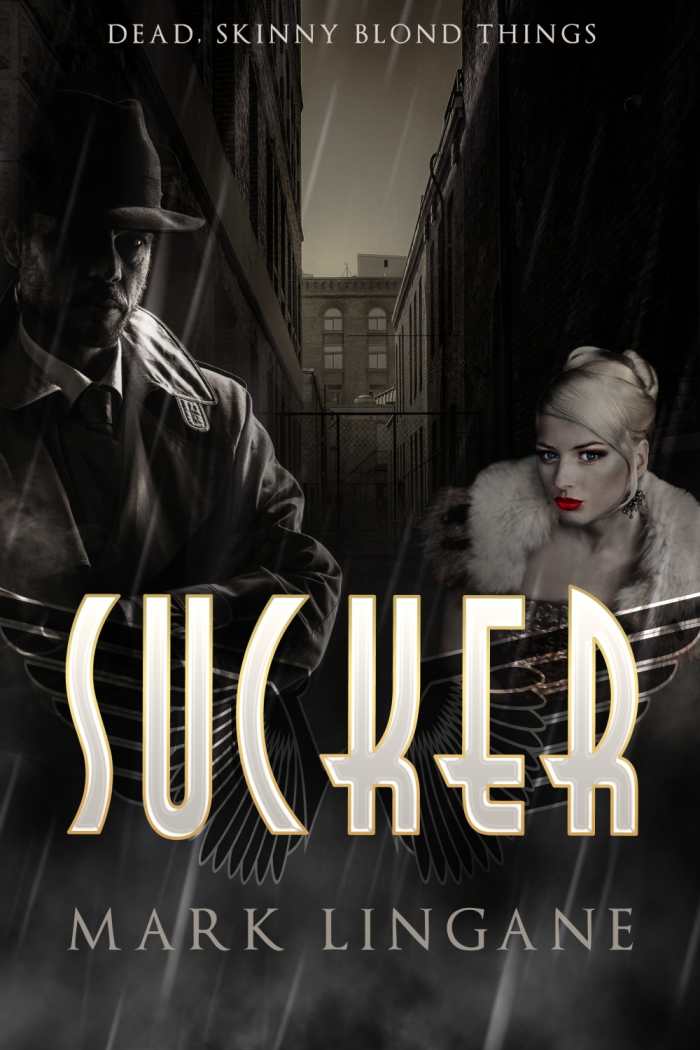
Mark Lingane
Insync Holdings
Softcover $14.99 (260pp)
978-1-5084-5598-1
Buy: Amazon
Snappy, funny noir mashes up with vampires and unholy ritual in this entertaining caper.
Van H. Avram doesn’t know much about vampires, but he does know about women. They seem to follow him everywhere: skinny, blond, dead women who appear to have had the very life sucked out of their bodies. As evidence explodes and strange dogs attack him, Avram is forced, reluctantly, to concede that something supernatural may be afoot. In fact, if things get any weirder, he may have to conclude that he’s at the very center of it all.
Steeped in 1950s PI glamour, it’s not hard to see the influence of Raymond Chandler in this energetic book. But Sucker also recalls Douglas Adams’s Dirk Gently’s Holistic Detective Agency, both in the absurdity of Avram’s interactions with his clientele and the cosmic implications of the cases he addresses out of his run-down yet barely affordable office. The book isn’t afraid to venture into overt goofiness, and in fact, this courage often invests it with a campy appeal that belies its complicated thematic mixture of noir, horror, and comedy.
Armchair detectives will enjoy Sucker‘s merry chase and strict adherence to the rules of its own universe. However, the story also leaves several loose ends untied, including a few baffling peripheral characters whose existence is never fully explained. It’s fairly easy to rationalize these based on clues present within the text, but readers who like their novels watertight may find that these little issues injure the book’s otherwise excellent polish.
Several of the people who surround Avram seem like stock characters at first introduction but quickly develop into unique and unusual creatures born completely of the book’s own world. The book’s depiction of women as lusty vixens may strike some feminist readers as problematic, though others may consider this is a wink to classic pulp fiction. Even when inhabiting this gray area, Sucker’s characters are fun to watch, even when not completely believable.
Stylistically, the book mimics the hard-bitten noir of the 1950s, but it updates linguistic and social conventions to better suit a modern audience. This choice works well, helping to imbue the book with sophistication that would have been absent in a straightforward homage to the genre. Sucker also adroitly handles enormous, even existential reveals in such a way that they fit into their context and remain surprising.
The potential audience for this book is broad. Science fiction, fantasy, and mystery fans are all likely to be on board from the first page, especially those who have been prepped by the recent popularity of silly-seeming, but ultimately high-quality, genre-crossing titles like Seth Grahame-Smith’s Abraham Lincoln: Vampire Hunter. However, anyone who enjoys religiously inclined fiction while simultaneously wishing that the subgenre took itself less seriously will enjoy this imaginative romp.
ANNA CALL (April 23, 2015)

Hannah Hohman is an editorial assistant at Foreword Reviews. You can contact her at hannah@forewordreviews.com.
Hannah Hohman
